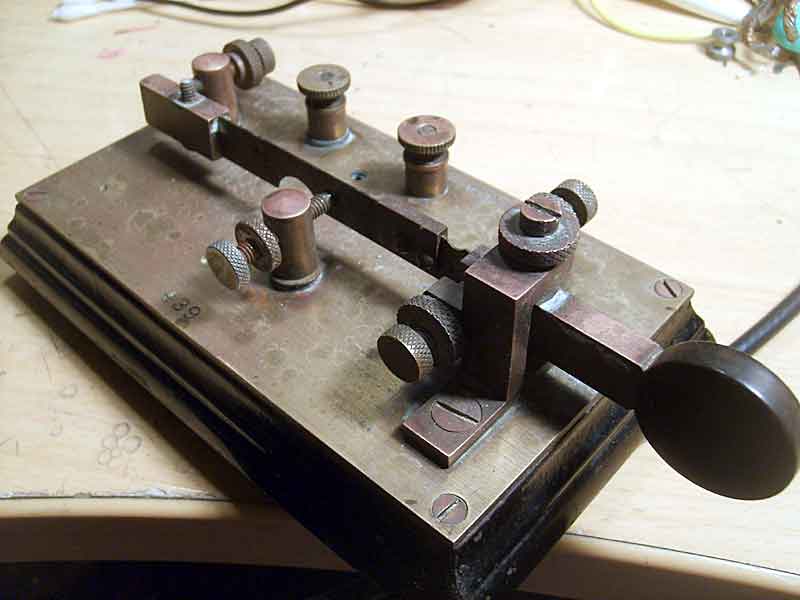
Saturday, Dec. 14, 2013, 10 p.m. — This evening I had some time to put some work into my new-to-me Gold Bug and take a few pics for the website.
In short, after some work and adjustment, the key plays surprisingly well. Let me add some photos to illustrate what’s up with the key:
 |
 |
 |
 |
From left: The Gold Bug as received (click images to enlarge); the lower pivot in the main frame. It is unique because the frame is a “half-frame” design. It works well regardless of the unconventional design; Serial number 439; the original dash contact (right) next to the repurposed one from a Les Logan Speed-X Model 510, (left). The original contact screw is missing its contact point, and it didn’t make good contact.
 |
 |
 |
 |
From left: I never realized this with my first Gold Bug, but the fixed part of the weight has a hole in it. On my first Gold Bug, it has a material stuffed in the hole that acts like a bumper. The hole on this one was empty. I took a knife and quickly cut up a pencil erase and fit it to the hole. Ugly, but hey, it works. The next three photos show the details of the dot and dash contacts. The second from left photo is the dot contact side of the lever. Peeking through the hole at right is the dot contact. Next photo to the right is the back side of the dot contact. It is a very thin leaf spring type material with a contact point mounted on it. The spring steel provides “give” when the key makes dots. It’s a neat method that avoids the usual Vibroplex-like dot spring. I sure don’t want to ever have to replace one, lol. Actually, you can see there is a clamp that fixes the contact spring and can be removed to replace the spring. Neat. At right right above is the dash contact. There is no spring or “give” there, but doesn’t really need it, either. Not the wear pattern on the dash contact; this is from making contact to the dash adjustment screw that had no contact point.
 |
 |
 |
I was so impressed by the way the dot contact spring works I thought I would use photos to illustrate. From left, photo 1: This is the neutral position for the keying lever. Photo 2 from left: When you make a dash, the keying lever flexes to the right. The weight stays against the bumper, and the tension put on the spring steel of the lever brings it back to neutral when the operator quits making the dash. At right, this photo shows the lever making a dit, with the contact post pushing the flexible spring steel slightly backward as the keying lever makes contact with the dot contact screw.

The finish of my new Bunnell Gold Bug appears to be have been polished at one time (one can see brass polish remnants on the key still). The other Gold Bug I own appears to have a lacquer finish that protects the brass. I think this is an original type of finish, as a polished brass finish dulls and tarnishes. My other Gold bug has a brushed finish too, an attractive finish.
To get my newest Gold Bug on the air, I had to add one of my homebrew bug tamers. This is nothing more than solder wrapped around a clip. I’m not a 30 wpm CW guy by a long shot; in fact, its going to take some practice to get back to 15 wpm. Also note that to get the key to play well I had to replace one of the contact screws with a donor from a derelict Les Logan Speed-X 510 key. The threads were the same, and while it isn’t brass, that contact point made all the difference in the world. The key is adjusted now and plays very, very well. I had heard these keys were difficult to adjust and use, which might be true if you have to spend an 8-hour shift sending copy. For more uses I think it’ll work ok.
ES TU, ROTOPLEX? I also took some time playing with my other recent acquisition, my Martin Rotoplex. I haven’t touched that key, but it appears its going to play just fine once I clean and adjust the contacts a bit. More on that later.
